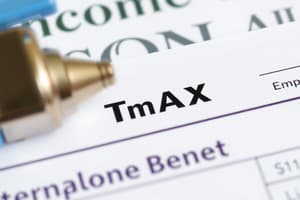Podcast
Questions and Answers
What government body administers India's income tax system?
What government body administers India's income tax system?
- Central Board of Direct Taxes (CBDT) (correct)
- Central Board of Indirect Taxes
- Reserve Bank of India
- Ministry of Finance
How are income tax rates in India characterized?
How are income tax rates in India characterized?
- They decrease as income increases
- They are progressive (correct)
- They are regressive
- They are fixed for all taxpayers
Which tax rates apply to companies in India?
Which tax rates apply to companies in India?
- 10% to 20%
- 5% to 30%
- 15% to 25% (correct)
- 20% to 35%
Which of the following is NOT a common income tax deduction in India?
Which of the following is NOT a common income tax deduction in India?
What is the objective behind introducing the Goods and Services Tax (GST) in India?
What is the objective behind introducing the Goods and Services Tax (GST) in India?
What are the four primary tax rates under the Goods and Services Tax (GST) system in India?
What are the four primary tax rates under the Goods and Services Tax (GST) system in India?
How does the GST system benefit consumers?
How does the GST system benefit consumers?
What impact has the GST system had on the Indian economy?
What impact has the GST system had on the Indian economy?
What challenge has the GST system faced in its implementation?
What challenge has the GST system faced in its implementation?
How has the GST system improved the efficiency of the supply chain?
How has the GST system improved the efficiency of the supply chain?
What is one of the future plans to address challenges in the GST system?
What is one of the future plans to address challenges in the GST system?
In conclusion, what positive changes has the GST system brought about?
In conclusion, what positive changes has the GST system brought about?
Flashcards are hidden until you start studying
Study Notes
Income Tax in India
Overview
India's income tax system is governed by the Income-tax Act, 1961, which is administered by the Central Board of Direct Taxes (CBDT) under the Ministry of Finance. The income tax is a direct tax levied on the income of individuals and businesses.
Tax Rates
The income tax rates in India are progressive, meaning the tax rate increases as the income increases. As of 2024, the income tax rates range from 5% to 30% for individuals, while for companies, the tax rates range from 15% to 25%.
Income Tax Deductions
The Income-tax Act, 1961, provides various deductions to individuals and businesses to reduce their taxable income. Some of the common deductions include deductions for investments in provident funds, contributions to superannuation funds, investments in tax-saving instruments like Public Provident Fund (PPF) and National Pension System (NPS), and donations to charitable organizations.
Goods and Services Tax (GST)
The Goods and Services Tax (GST) is an indirect tax system that was introduced in India in 2017 to replace multiple indirect taxes. It is a uniform tax levied on the supply of goods and services across the country, with the objective of simplifying the tax system and reducing tax evasion.
The GST system is made up of four tax rates: 5%, 12%, 18%, and 28%; there is also an additional tax of 0.25% for goods and services under the reverse charge mechanism. Under the GST system, the tax is calculated at each stage of the supply chain, with the benefit of set-off of taxes paid at previous stages. This helps in eliminating the cascading effect of taxes, thereby reducing the tax burden for consumers.
Impact of GST
The introduction of GST has had a significant impact on the Indian economy. It has streamlined the tax system, reduced compliance costs for businesses, and increased the tax base by bringing more small and unorganized businesses into the formal tax system. The GST system has also led to the reduction of inter-state checkpoints, which has improved the efficiency of the supply chain and reduced logistics costs.
Challenges and Future Plans
Despite its benefits, the GST system has faced challenges in its implementation, such as complex tax structures, lack of clarity in taxation, and the need for a more robust IT infrastructure. To address these challenges, the government plans to introduce a centralized portal for indirect tax compliance, which will streamline the process of filing returns, generating e-invoices, and managing e-way bills.
Conclusion
The income tax system in India has evolved significantly over the years, with the introduction of the GST system being a significant milestone. Although the system has faced challenges, it has brought about several positive changes, including simplifying the tax structure, reducing compliance costs, and improving the efficiency of the supply chain. As the government continues to work on improving the GST system, it remains a key aspect of India's taxation policy.
Studying That Suits You
Use AI to generate personalized quizzes and flashcards to suit your learning preferences.




